TOYOTA C-HR 2022 Owners Manual
Manufacturer: TOYOTA, Model Year: 2022, Model line: C-HR, Model: TOYOTA C-HR 2022Pages: 818, PDF Size: 113.75 MB
Page 541 of 818
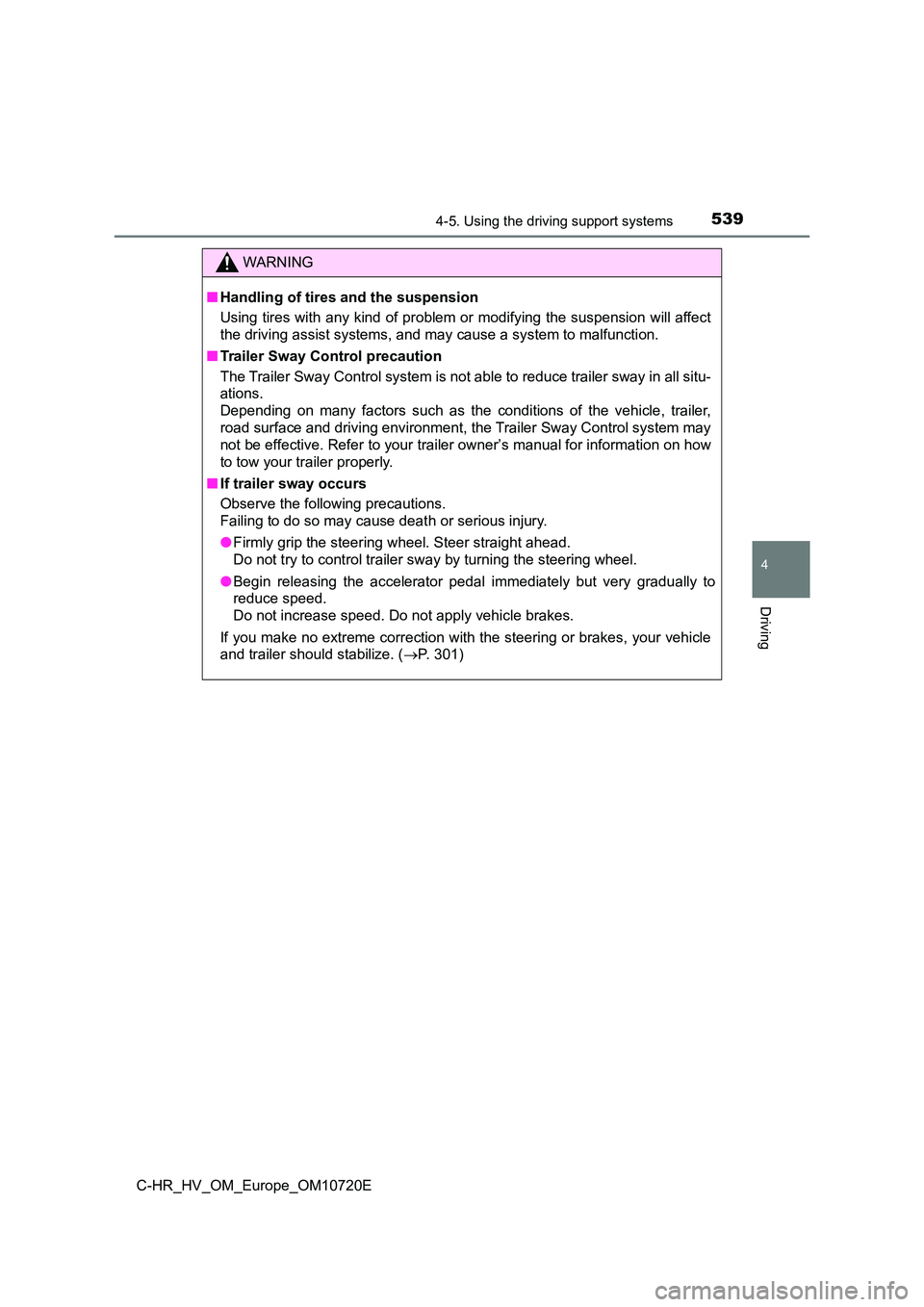
5394-5. Using the driving support systems
4
Driving
C-HR_HV_OM_Europe_OM10720E
WARNING
■Handling of tires and the suspension
Using tires with any kind of problem or modifying the suspensio n will affect
the driving assist systems, and may cause a system to malfuncti on.
■ Trailer Sway Control precaution
The Trailer Sway Control system is not able to reduce trailer s way in all situ-
ations.
Depending on many factors such as the conditions of the vehicle , trailer,
road surface and driving environm ent, the Trailer Sway Control system may
not be effective. Refer to your trailer owner’s manual for info rmation on how
to tow your trailer properly.
■ If trailer sway occurs
Observe the following precautions.
Failing to do so may cause death or serious injury.
● Firmly grip the steering wheel. Steer straight ahead.
Do not try to control trailer sway by turning the steering whee l.
● Begin releasing the accelerator pedal immediately but very gradually to
reduce speed.
Do not increase speed. Do not apply vehicle brakes.
If you make no extreme correction with the steering or brakes, your vehicle
and trailer should stabilize. ( P. 301)
Page 542 of 818
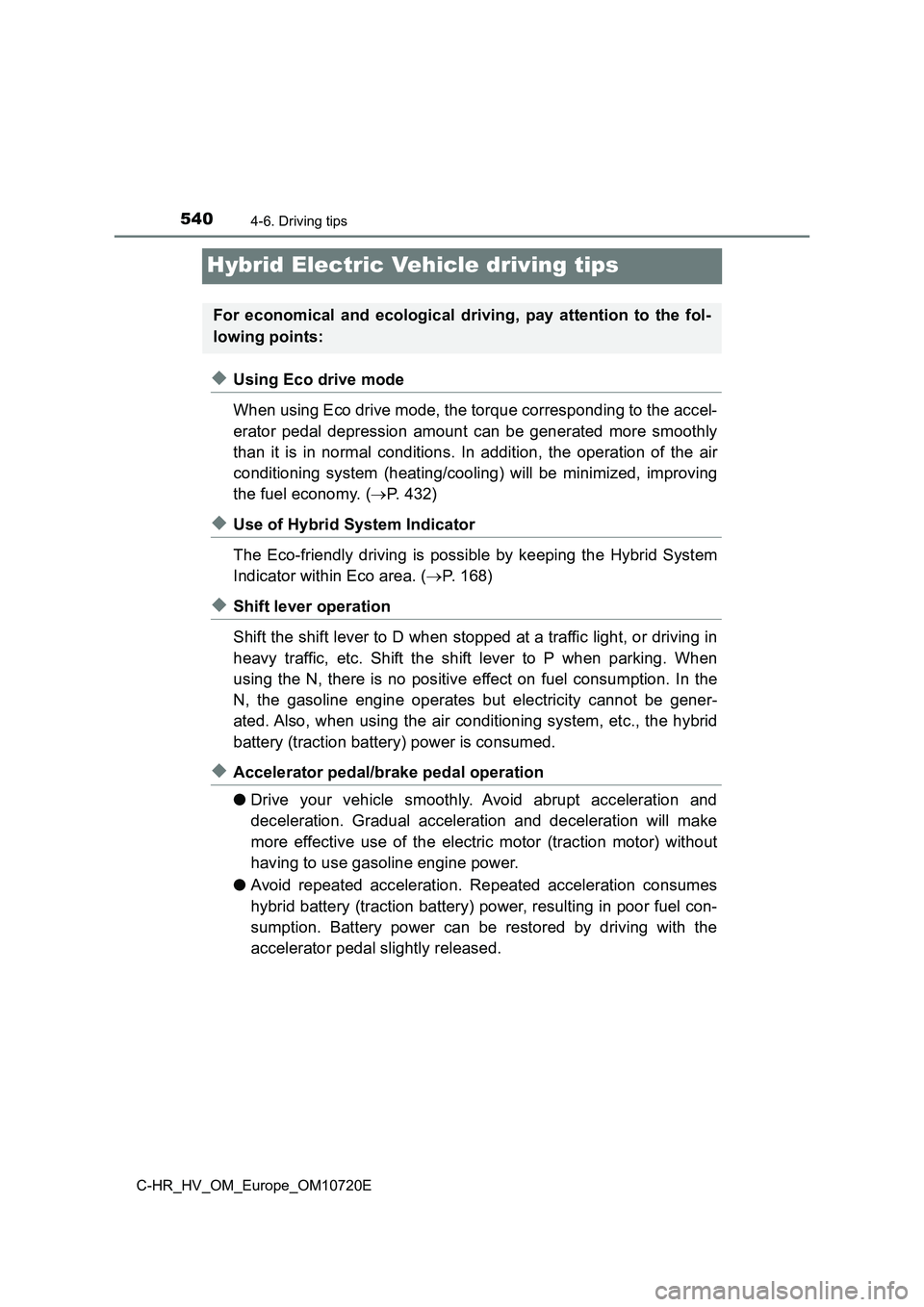
5404-6. Driving tips
C-HR_HV_OM_Europe_OM10720E
Hybrid Electric Vehicle driving tips
◆Using Eco drive mode
When using Eco drive mode, the torque corresponding to the acce l-
erator pedal depression amount can be generated more smoothly
than it is in normal conditions. In addition, the operation of the air
conditioning system (heating/cooling) will be minimized, improv ing
the fuel economy. ( P. 4 3 2 )
◆Use of Hybrid System Indicator
The Eco-friendly driving is possible by keeping the Hybrid Syst em
Indicator within Eco area. ( P. 168)
◆Shift lever operation
Shift the shift lever to D when stopped at a traffic light, or driving in
heavy traffic, etc. Shift the shift lever to P when parking. Wh en
using the N, there is no positive effect on fuel consumption. I n the
N, the gasoline engine operates but electricity cannot be gener -
ated. Also, when using the air conditioning system, etc., the h ybrid
battery (traction battery) power is consumed.
◆Accelerator pedal/brake pedal operation
● Drive your vehicle smoothly. Avoid abrupt acceleration and
deceleration. Gradual acceleration and deceleration will make
more effective use of the electric motor (traction motor) witho ut
having to use gasoline engine power.
● Avoid repeated acceleration. Repeated acceleration consumes
hybrid battery (traction battery) power, resulting in poor fuel con-
sumption. Battery power can be restored by driving with the
accelerator pedal slightly released.
For economical and ecological driving, pay attention to the fol -
lowing points:
Page 543 of 818
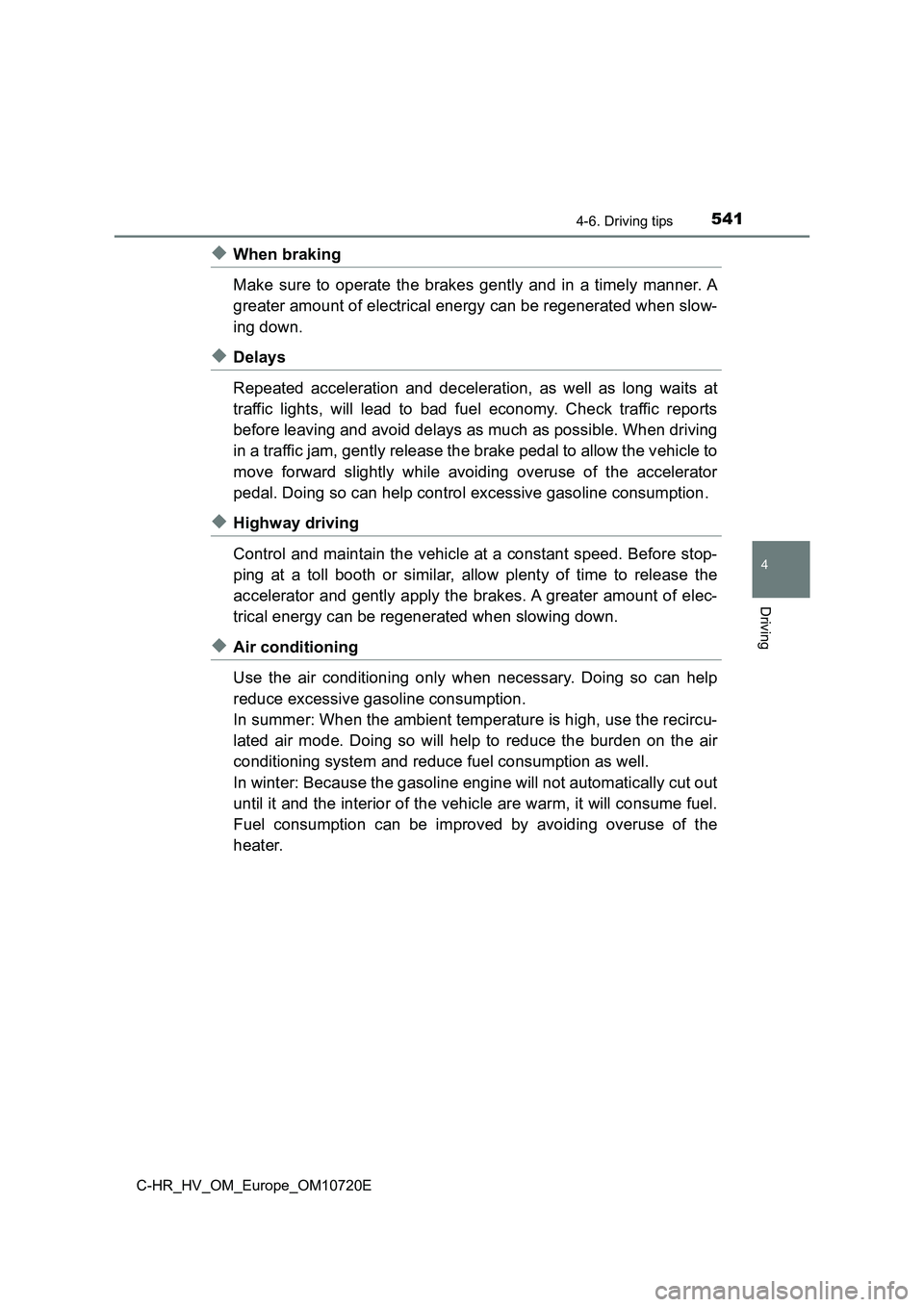
5414-6. Driving tips
4
Driving
C-HR_HV_OM_Europe_OM10720E
◆When braking
Make sure to operate the brakes gently and in a timely manner. A
greater amount of electrical energy can be regenerated when slo w-
ing down.
◆Delays
Repeated acceleration and deceleration, as well as long waits a t
traffic lights, will lead to bad fuel economy. Check traffic re ports
before leaving and avoid delays as much as possible. When drivi ng
in a traffic jam, gently release the brake pedal to allow the v ehicle to
move forward slightly while avoiding overuse of the accelerator
pedal. Doing so can help control excessive gasoline consumption .
◆Highway driving
Control and maintain the vehicle at a constant speed. Before st op-
ping at a toll booth or similar, allow plenty of time to releas e the
accelerator and gently apply the brakes. A greater amount of el ec-
trical energy can be regenerated when slowing down.
◆Air conditioning
Use the air conditioning only when necessary. Doing so can help
reduce excessive gasoline consumption.
In summer: When the ambient temperature is high, use the recirc u-
lated air mode. Doing so will help to reduce the burden on the air
conditioning system and reduce fuel consumption as well.
In winter: Because the gasoline engine will not automatically c ut out
until it and the interior of the vehicle are warm, it will cons ume fuel.
Fuel consumption can be improved by avoiding overuse of the
heater.
Page 544 of 818
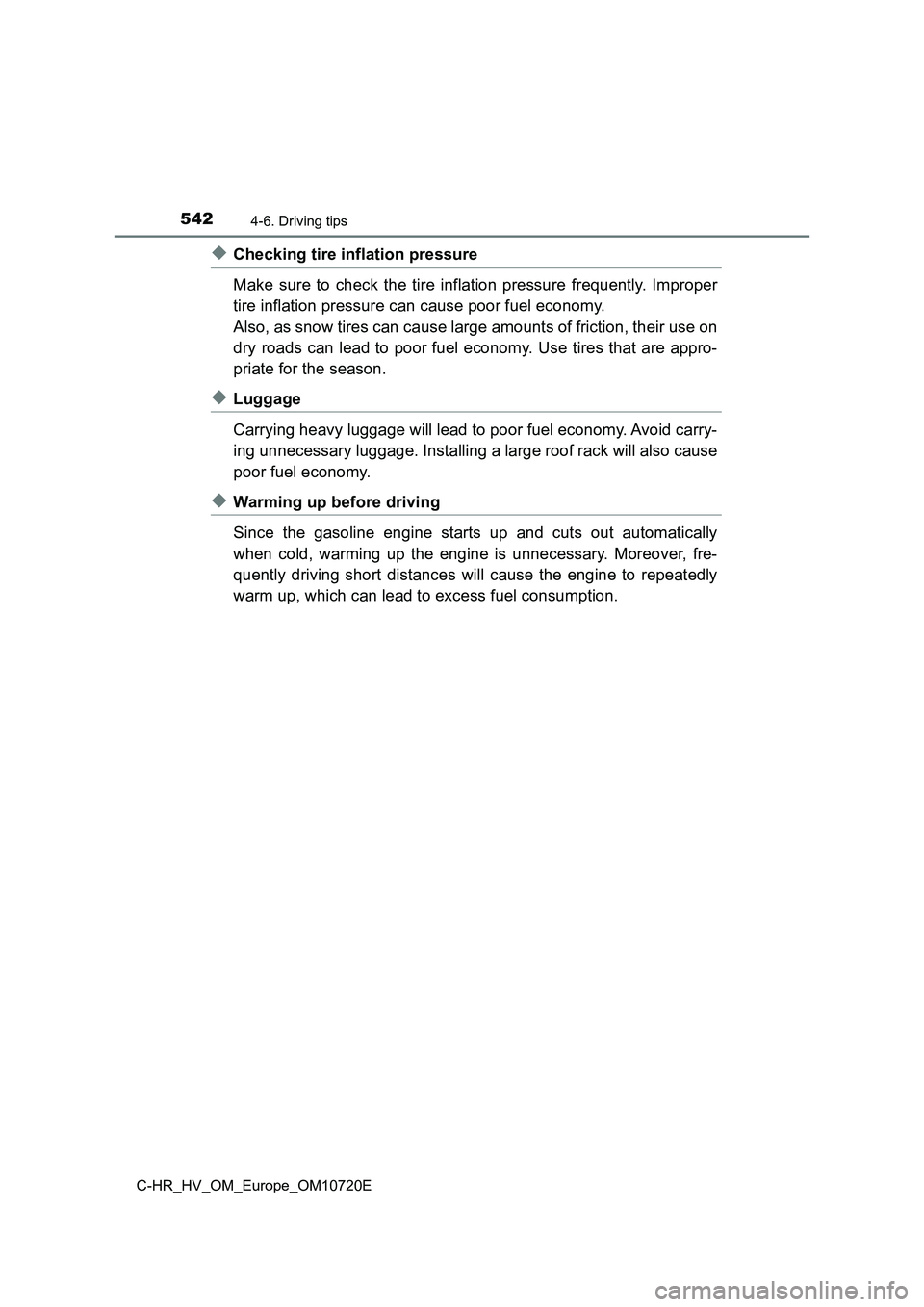
5424-6. Driving tips
C-HR_HV_OM_Europe_OM10720E
◆Checking tire inflation pressure
Make sure to check the tire inflation pressure frequently. Impr oper
tire inflation pressure can cause poor fuel economy.
Also, as snow tires can cause large amounts of friction, their use on
dry roads can lead to poor fuel economy. Use tires that are app ro-
priate for the season.
◆Luggage
Carrying heavy luggage will lead to poor fuel economy. Avoid ca rry-
ing unnecessary luggage. Installing a large roof rack will also cause
poor fuel economy.
◆Warming up before driving
Since the gasoline engine starts up and cuts out automatically
when cold, warming up the engine is unnecessary. Moreover, fre-
quently driving short distances will cause the engine to repeat edly
warm up, which can lead to excess fuel consumption.
Page 545 of 818

543
4
4-6. Driving tips
Driving
C-HR_HV_OM_Europe_OM10720E
Winter driving tips
●Use fluids that are appropriate to the prevailing outside tempera-
tures.
• Engine oil
• Engine/power control unit coolant
• Washer fluid
● Have a service technician inspect the condition of the 12-volt bat-
tery.
● Have the vehicle fitted with four snow tires or purchase a set of tire
chains for the front tires*.
Ensure that all tires are the same size and brand, and that cha ins match
the size of the tires.
*: Tire chains cannot be mounted on 18-inch tires or 19-inch tir es.
Perform the following according to the driving conditions:
● Do not try to forcibly open a window or move a wiper that is frozen.
Pour warm water over the frozen area to melt the ice. Wipe away
the water immediately to prevent it from freezing.
● To ensure proper operation of the climate control system fan,
remove any snow that has accumulated on the air inlet vents in
front of the windshield.
● Check for and remove any excess ice or snow that may have accu-
mulated on the exterior lights, vehicle’s roof, chassis, around the
tires or on the brakes.
● Remove any snow or mud from the bottom of your shoes before
getting in the vehicle.
Carry out the necessary preparations and inspections before
driving the vehicle in winter. Always drive the vehicle in a ma n-
ner appropriate to the prevailing weather conditions.
Preparation for winter
Before driving the vehicle
Page 546 of 818
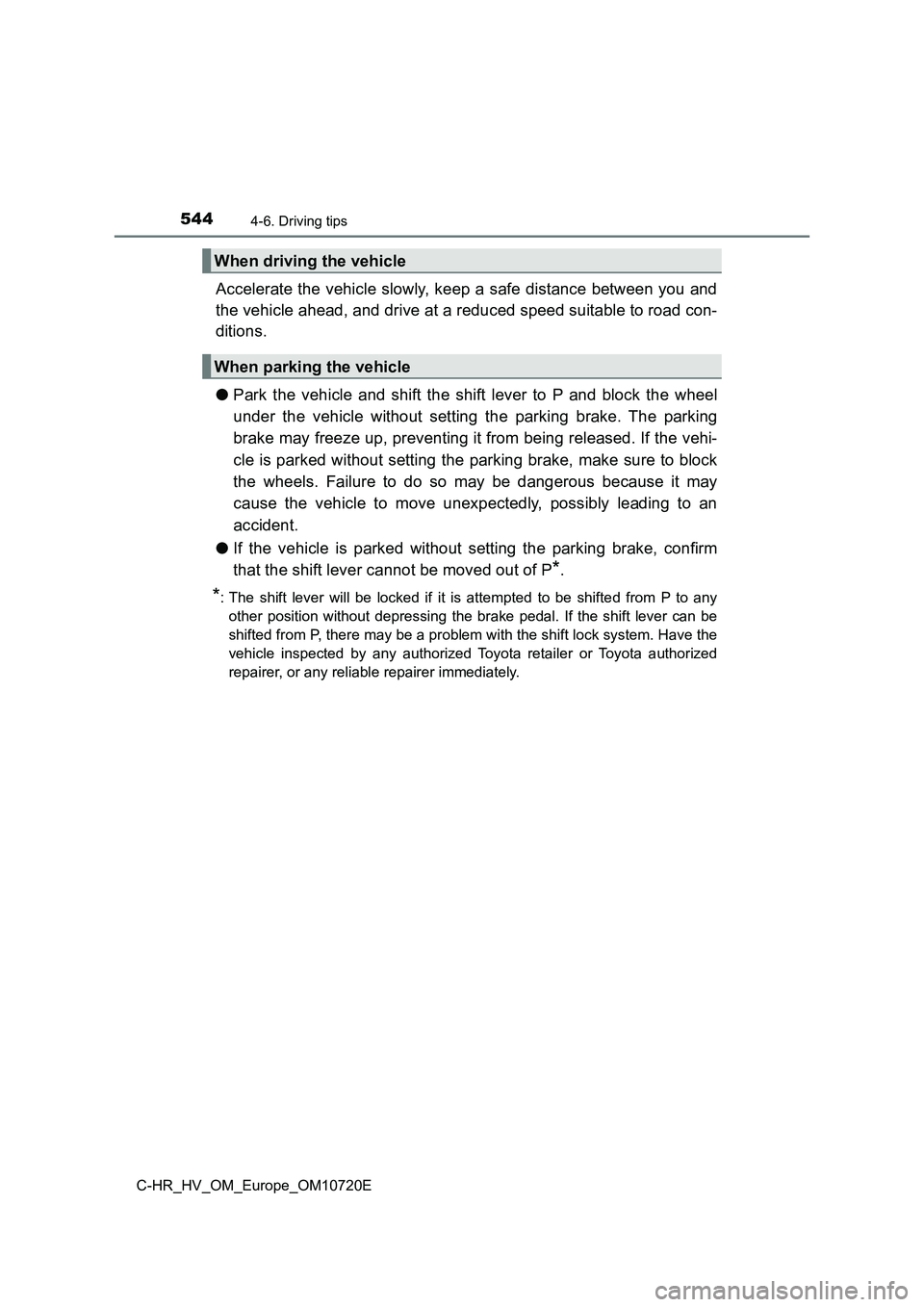
5444-6. Driving tips
C-HR_HV_OM_Europe_OM10720E
Accelerate the vehicle slowly, keep a safe distance between you and
the vehicle ahead, and drive at a reduced speed suitable to roa d con-
ditions.
● Park the vehicle and shift the shift lever to P and block the wheel
under the vehicle without setting the parking brake. The parkin g
brake may freeze up, preventing it from being released. If the vehi-
cle is parked without setting the parking brake, make sure to b lock
the wheels. Failure to do so may be dangerous because it may
cause the vehicle to move unexpectedly, possibly leading to an
accident.
● If the vehicle is parked without setting the parking brake, confirm
that the shift lever cannot be moved out of P*.
*: The shift lever will be locked if it is attempted to be shifte d from P to any
other position without depressing the brake pedal. If the shift lever can be
shifted from P, there may be a problem with the shift lock syst em. Have the
vehicle inspected by any authorized Toyota retailer or Toyota a uthorized
repairer, or any reliabl e repairer immediately.
When driving the vehicle
When parking the vehicle
Page 547 of 818
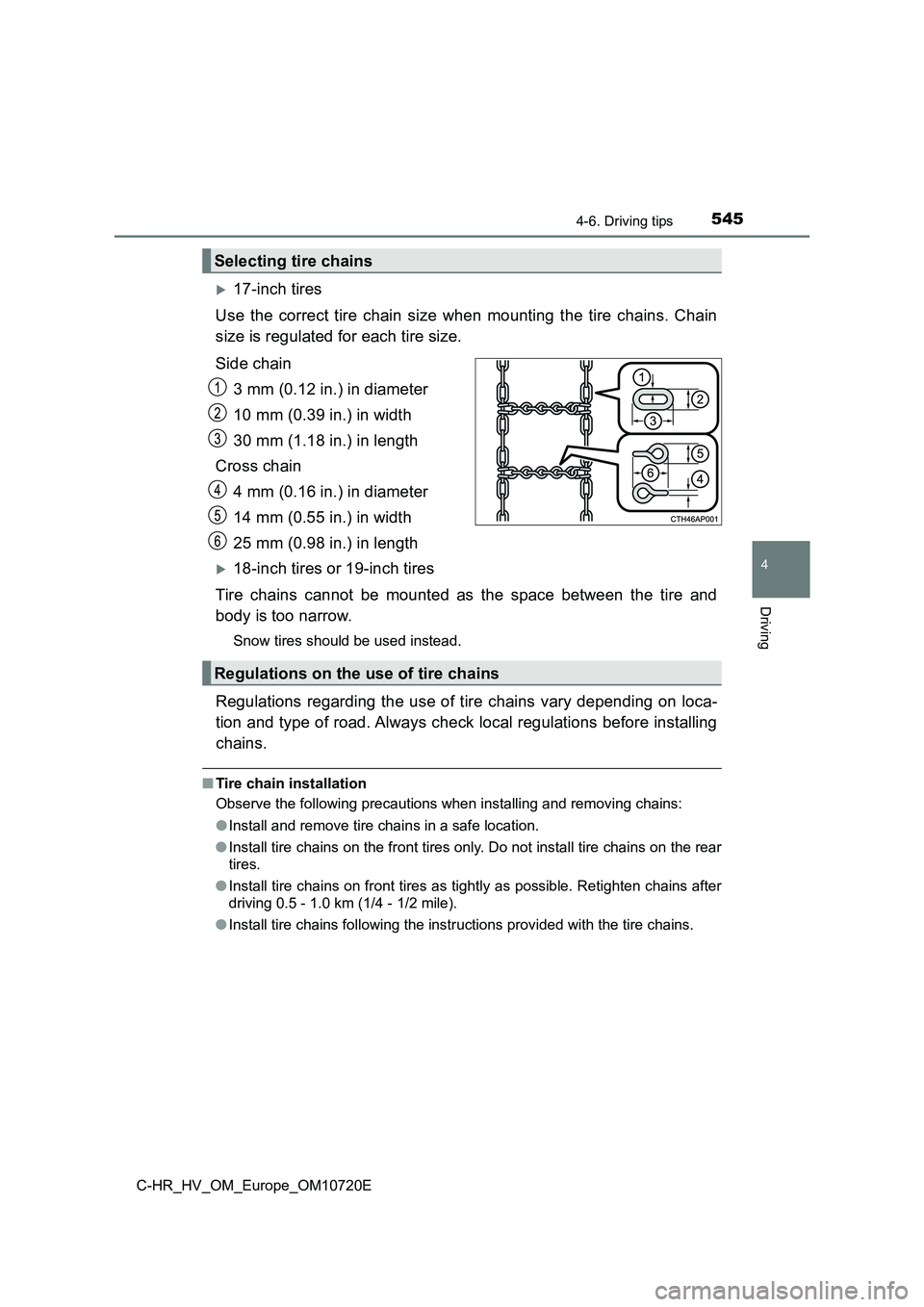
5454-6. Driving tips
4
Driving
C-HR_HV_OM_Europe_OM10720E
17-inch tires
Use the correct tire chain size when mounting the tire chains. Chain
size is regulated for each tire size.
Side chain
3 mm (0.12 in.) in diameter
10 mm (0.39 in.) in width
30 mm (1.18 in.) in length
Cross chain
4 mm (0.16 in.) in diameter
14 mm (0.55 in.) in width
25 mm (0.98 in.) in length
18-inch tires or 19-inch tires
Tire chains cannot be mounted as the space between the tire and
body is too narrow.
Snow tires should be used instead.
Regulations regarding the use of tire chains vary depending on loca-
tion and type of road. Always check local regulations before in stalling
chains.
■ Tire chain installation
Observe the following precautions when installing and removing chains:
● Install and remove tire chains in a safe location.
● Install tire chains on the front tires only. Do not install tire chains on the rear
tires.
● Install tire chains on front tires as tightly as possible. Retighten chains after
driving 0.5 - 1.0 km (1/4 - 1/2 mile).
● Install tire chains following the instructions provided with the tire chains.
Selecting tire chains
Regulations on the use of tire chains
Page 548 of 818
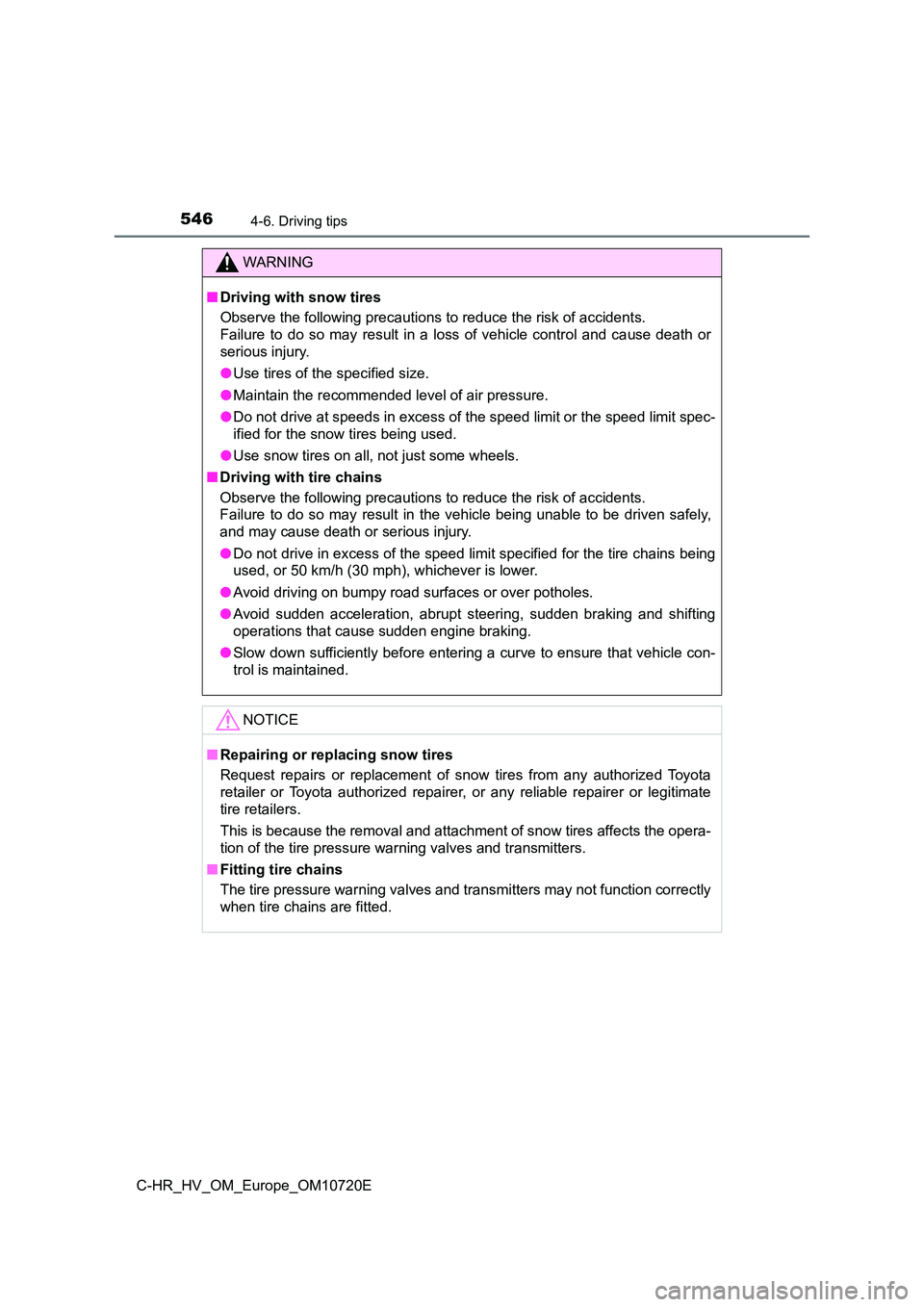
5464-6. Driving tips
C-HR_HV_OM_Europe_OM10720E
WARNING
■Driving with snow tires
Observe the following precautions to reduce the risk of acciden ts.
Failure to do so may result in a loss of vehicle control and ca use death or
serious injury.
● Use tires of the specified size.
● Maintain the recommended level of air pressure.
● Do not drive at speeds in excess of the speed limit or the speed limit spec-
ified for the snow tires being used.
● Use snow tires on all, not just some wheels.
■ Driving with tire chains
Observe the following precautions to reduce the risk of acciden ts.
Failure to do so may result in the vehicle being unable to be d riven safely,
and may cause death or serious injury.
● Do not drive in excess of the speed limit specified for the tire chains being
used, or 50 km/h (30 mph), whichever is lower.
● Avoid driving on bumpy road surfaces or over potholes.
● Avoid sudden acceleration, abrupt steering, sudden braking and shifting
operations that cause sudden engine braking.
● Slow down sufficiently before entering a curve to ensure that vehicle con-
trol is maintained.
NOTICE
■ Repairing or replacing snow tires
Request repairs or replacement of snow tires from any authorize d Toyota
retailer or Toyota authorized repairer, or any reliable repaire r or legitimate
tire retailers.
This is because the removal and attachment of snow tires affect s the opera-
tion of the tire pressure warning valves and transmitters.
■ Fitting tire chains
The tire pressure warning valves and transmitters may not funct ion correctly
when tire chains are fitted.
Page 549 of 818
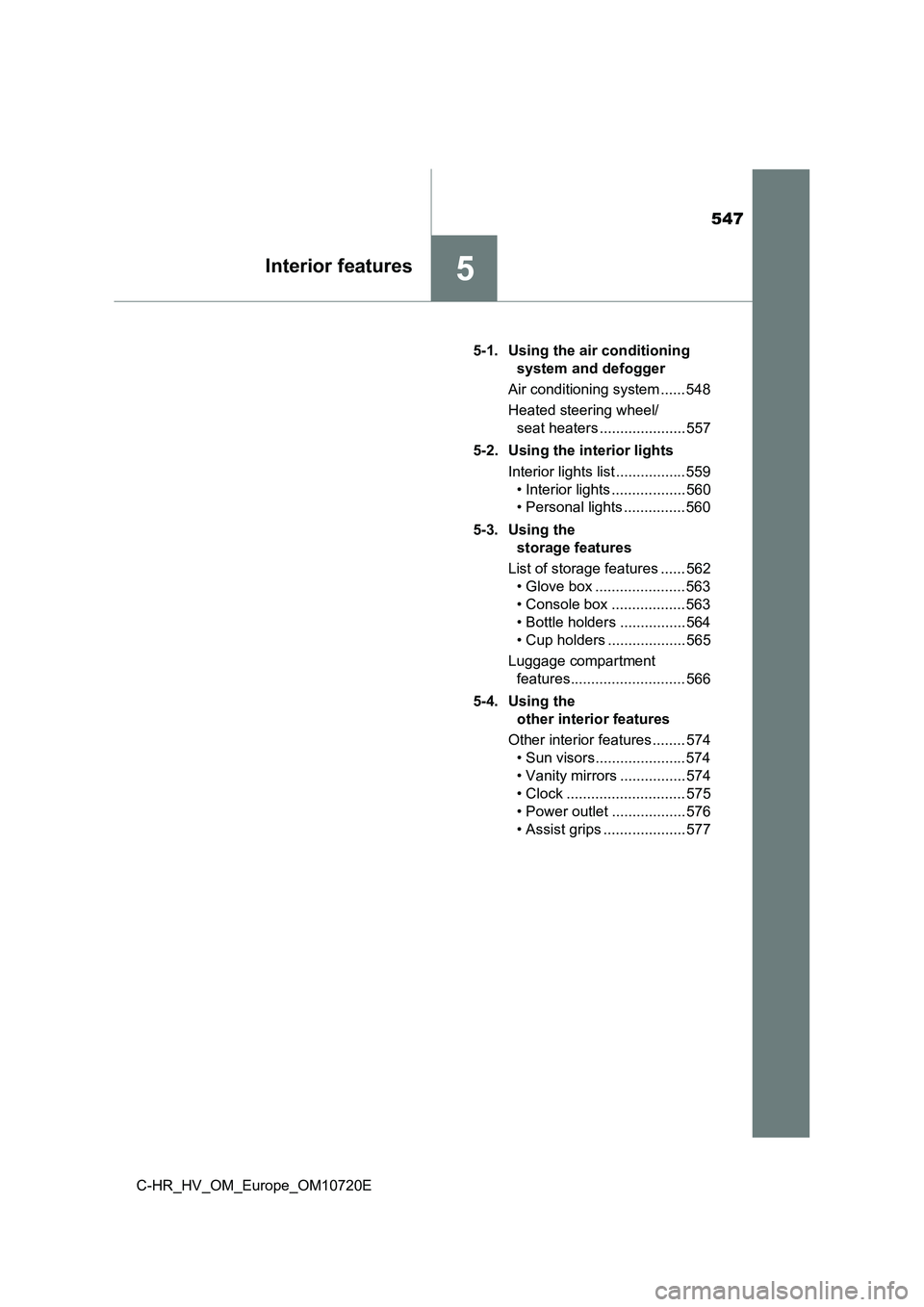
547
5Interior features
C-HR_HV_OM_Europe_OM10720E
5-1. Using the air conditioning
system and defogger
Air conditioning system ...... 548
Heated steering wheel/
seat heaters ..................... 557
5-2. Using the interior lights
Interior lights list ................. 559
• Interior lights .................. 560
• Personal lights ............... 560
5-3. Using the
storage features
List of storage features ...... 562
• Glove box ...................... 563
• Console box .................. 563
• Bottle holders ................ 564
• Cup holders ................... 565
Luggage compartment
features............................ 566
5-4. Using the
other interior features
Other interior features ........ 574
• Sun visors...................... 574
• Vanity mirrors ................ 574
• Clock ............................. 575
• Power outlet .................. 576
• Assist grips .................... 577
Page 550 of 818
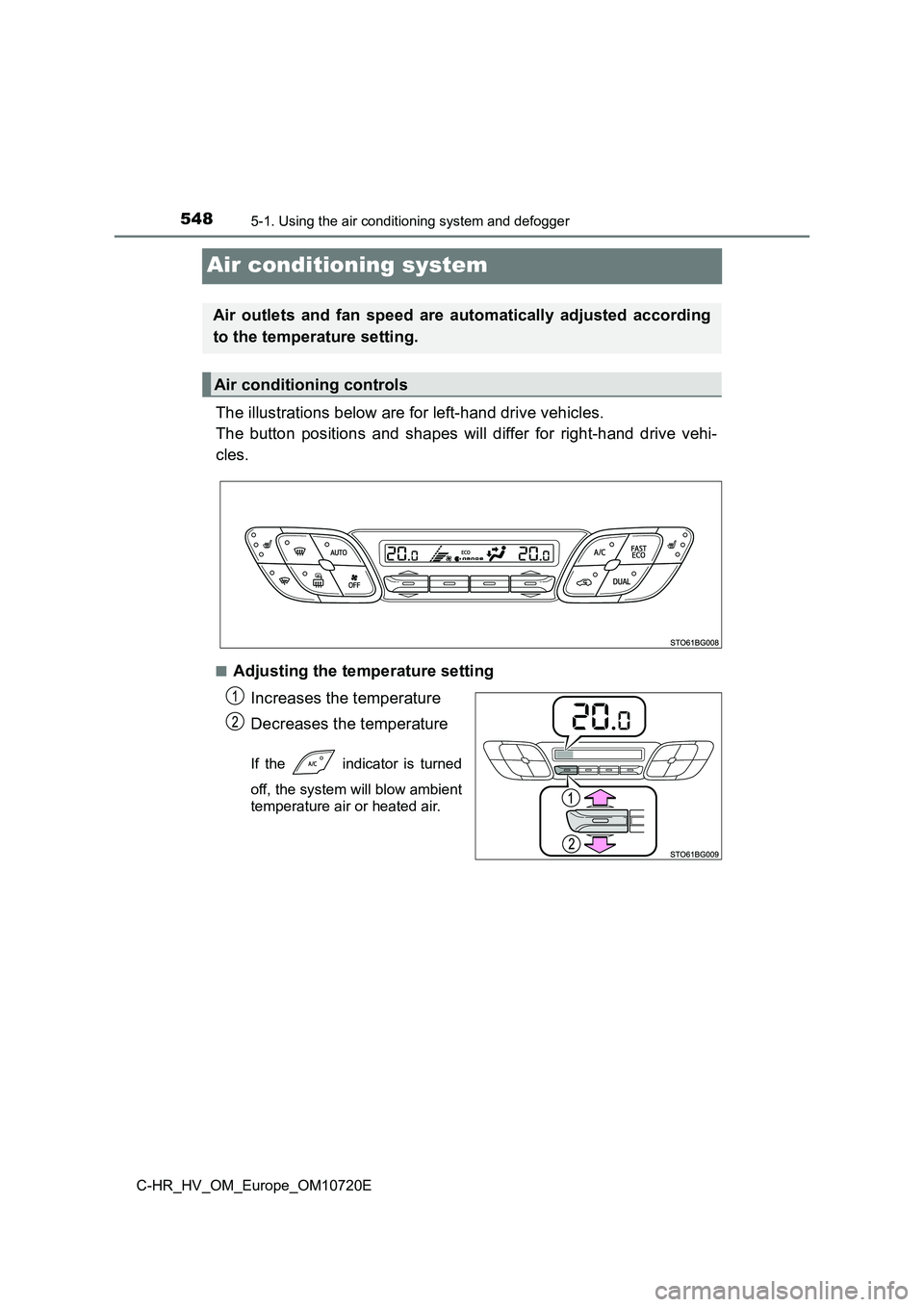
5485-1. Using the air conditioning system and defogger
C-HR_HV_OM_Europe_OM10720E
Air conditioning system
The illustrations below are for left-hand drive vehicles.
The button positions and shapes will differ for right-hand driv e vehi-
cles.
■Adjusting the temperature setting
Increases the temperature
Decreases the temperature
If the indicator is turned
off, the system will blow ambient
temperature air or heated air.
Air outlets and fan speed are automatically adjusted according
to the temperature setting.
Air conditioning controls